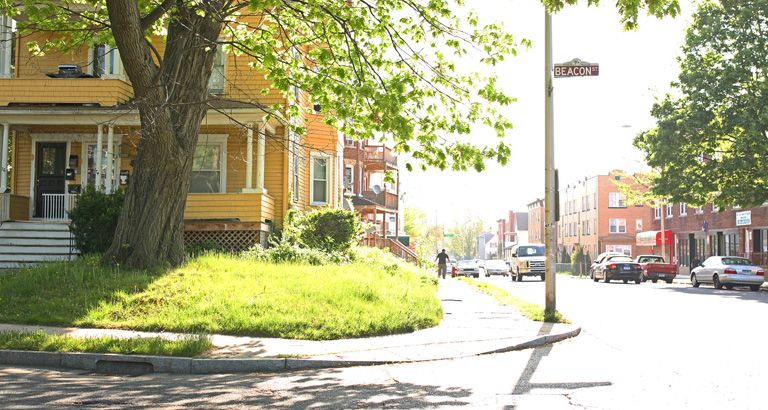
Image courtesy of Hartford Community Loan Fund
Like a lot of folks in the community development field, I migrated from the corporate world. Twenty years ago, after a dozen years in banking, a merger between my Hartford-based bank and one headquartered in Boston forced me to relocate or find a different job. I wanted to stay in Connecticut, so I chose the latter.
I was surprised when, a few months later, the board of a start-up nonprofit loan fund in Hartford extended an offer of employment—but with a condition attached: I would need to relocate.
The board of the South Hartford Initiative felt strongly that the organization’s executive director should live in the city where the nonprofit was based.
It wasn’t like I’d been living in another state. Throughout the course of my career at the bank, I’d commuted to the bank’s Hartford headquarters from Middletown, a working-class town of about 45,000 located just 20 minutes outside of the capital city. I had developed roots and a sense of community there that I valued and didn’t want to leave.
At the same time, I was excited for the opportunity to be part of something new. I wanted to see if the tools I’d developed at the bank, where I had most recently been providing financing to publicly traded health care companies, could be applied at the grassroots level and into an urban environment. While Hartford in 2018 still has plenty of struggles, 20 years ago the city was mired in especially deep troubles, with gangs like Los Solidos, Twenty Love, and the Latin Kings running roughshod over the city’s neighborhoods, driving out small-businesses and residents in droves. Property values had plummeted. What was once America’s wealthiest city had become one of its poorest.
So, even though I didn’t really ‘get’ the homesteading requirement, I bit the bullet. Three months after starting the new job, I closed on a small colonial in the deep southend of Hartford, buying from someone who, 10 years after purchasing the same house, was now $30,000 underwater and eager to stop the bleeding in order to bolt for the stability of the suburbs.
I found a small office space for us (well, mainly me) in a boarded up, but reasonably maintained house a mile or so from my new home. The neighborhood, just south of downtown, had been especially hard hit by gang fighting and at the time was wrestling with a concentration of prostitution activity centered around three neighborhood “massage” parlors. One was a block up from our new office.
Soon I learned why my board members felt so strongly about the residency requirement—80 percent of them lived in the southend of the city themselves, an area only about five square miles. Many were longtime southenders and had grown up through the late 1960s to the early ‘80s when Hartford’s destiny had been primarily shaped not by elected officials who resided in the city, but by a group of men (all white) known as the ‘Bishops’—CEOs from Hartford’s large insurance companies who had developed and driven their own vision for the city.
While the Bishops had been credited with luring the Whalers hockey team from Boston to Hartford in 1974 (the Whalers later became part of the NHL before they moved to North Carolina in 1997) and oversaw the construction of the downtown Civic Center along with a few other downtown landmarks, they were in fact outsiders with little exposure to or understanding of Hartford’s neighborhoods and its increasingly diverse population. Hartford is now about 45 percent Latinx, 35 percent African American and West Indian, and 20 percent “other,” and in total, about 35 percent of residents live at or below the poverty level. Few of the Bishops ever lived in Hartford, sent their kids to Hartford schools, or spent meaningful time in Hartford’s neighborhoods.
Long after his retirement, John Filer, CEO of Aetna from 1972 to 1984 and considered the most powerful of the Bishops, confessed in an article in The New York Times, “We (the corporate CEOs) were benevolent despots, if you will; but,” he added, “I don’t like any system that puts into the hands of a few who are not elected an unusual amount of power—I think it’s a dangerous thing to do.”
I could sense that the members of my board had developed a distinct distrust for outsiders, and felt it would be a dangerous thing to entrust the fate of their organization to one. They’d witnessed both the hubris and the mistakes made by smart, well-meaning, but somewhat ill-informed civic leaders, including many who led the area’s nonprofits, who commuted into Hartford five days a week from safer confines in other towns. The South Hartford Initiative, they had determined, would be led by someone who lived in south Hartford.
The organization grew and, 10 years after I originally signed on, evolved into the Hartford Community Loan Fund, a citywide community development financial institution (CDFI). In 2016 the board voted to expand our investment area to the greater Hartford region.
Around the time of our expansion, I sold my southend home and moved to Hartford’s north end, which includes the city’s more economically challenged and disinvested blocks. I knew the bulk of our future lending should be in the city’s most distressed neighborhoods, once red-lined by the very bank I’d worked for, and I knew it would be important for me to see, on a daily basis, where we were—and weren’t yet—investing our capital.
I don’t think that every community development professional has to live in the neighborhood they are working in to better understand the issues confronting that community. Many of my mentors in the field have intentionally separated the geographies of their personal and professional lives. Still, looking in the rearview mirror 20 years later, it’s hard to overstate how wise I think that original group of board members was in imposing its residency requirement on me. While initially skeptical, over the years I’ve learned some powerful lessons about the benefits of proximity:
Lesson No. 1: Proximity Creates Better Products and Services
When the South Hartford Initiative opened its doors, the State of Connecticut (which provided our initial capital) restricted our lending to small businesses and residential home improvement loans. It didn’t take long for us to realize that there were other alternative lenders already providing both types of loans, sometimes at cheaper rates and with looser underwriting. Was there possibly a more critical need for our capital elsewhere? My neighbors had answers.
The downturn in the real estate market had left scores of abandoned, boarded up residential and mixed-use buildings in their neighborhoods, and eventually, on my own block. Neither the banks nor the other nonprofit lenders were financing the purchase or rehab of these properties. My neighbors knew I worked at a place that provided loans—why can’t your organization provide loans to fix up these eyesores, they asked. Within a couple of years, we’d eliminated those redundant loan products and introduced our construction-rehab loan program. Created with input from our community, our construction-rehab loans have now financed the rehab of nearly 200 formerly abandoned, boarded-up properties throughout every neighborhood in our city.
Lesson No. 2: Proximity Shapes Perspective
For five years after I’d moved into Hartford’s north end, I volunteered to live in and oversee a faith-based community house where, from time to time, we’d provide a safe space for homeless youth to stay. One of the young men who spent about a year with us was later involved in a tragic and senseless murder a few blocks from our house. DJ (not his real name) was 18 years old at the time of the shooting. He’s 24 now and will likely be locked up until he’s 60. While I don’t absolve DJ for what he did (although he didn’t pull the trigger of the murder weapon himself), through my visits with him in prison, and my witnessing the targeting of other young men of color in my neighborhood, my perspective on our system of incarceration has been challenged and forever changed.
During some of our visits, DJ would talk to me about one of his mentors in prison, an older inmate named Anthony (also not his real name). Anthony and DJ are both intellectually gifted and were classmates in Wesleyan University’s highly competitive and rigorous Center for Prison Education. Anthony had already served nearly 20 years for a murder he committed at age 17, but as the result of a U.S. Supreme Court decision, Anthony was going to be given an unexpected opportunity for parole.
After meetings in the prison and several letters with Anthony, I knew our organization and our community would benefit if we had an opportunity to tap into Anthony’s talents and perspective. No one on our staff had experienced incarceration, but as a result of the nearly six-fold increase in the prison population over the past four decades, more than one-third of the families in the neighborhoods we serve has a loved one either in prison or on parole; several of our current and past borrowers have been incarcerated; and one of our borrowers—a neighbor of mine—is scheduled to be sentenced next week.
Along with a few dozen letters of recommendation, mostly from Wesleyan professors and some other prison supervisors, my letter offering Anthony employment at the Loan Fund was included in the package of materials presented to his Parole Board. Anthony was extended an early release and has been living in Hartford and working for our organization as a policy analyst for the past year. Although he’s new to Hartford, in many ways Anthony’s already demonstrated more natural connections in our community and has woven himself into the civic fabric of Hartford better than me or anyone else in our organization.
Someone who I once would have sadly been more likely to view as a potential liability, I now understand is actually a critical asset.
Lesson No. 3: Proximity Brings Positive, Public Pressure
What started with our former mayor’s 2011 request for us to finance a small, start-up grocery store downtown (we declined for a variety of reasons) led to a full-fledged effort to eliminate Hartford’s food desert from 2012 to 2014. The small start-up failed after six months, but as a CDFI with access to the Healthy Foods Financing Initiative, we knew there were available resources we could leverage to help bring a sustainable, full-service supermarket to Hartford, which had been ranked as the 8th worst food desert for cities of its size in the U.S. Within 18 months, we completed a market study, secured a ShopRite operator, and identified an experienced developer with access to financing. The city offered a 3.5-acre parcel ideally located on a dozen bus lines and within walking distance to the rapidly growing population of downtown residents. Projections indicated our supermarket would recapture nearly 75 percent of the $40 million that Hartford residents were spending each year buying groceries in the suburbs. And the majority of shoppers would most likely come from my neighborhood, where the rate of diet-related diseases was among the worst in the state.
But an announcement by our then-mayor and City Council in June of 2014 pulled the rug from under our plans. The city would both build and fully finance a new minor league baseball stadium across the street from our proposed supermarket.
We were blind-sided. The day after the mayor’s proclamation from the steps of City Hall, both the supermarket operator and our developer called me to express significant concerns about the viability of our project in an “entertainment zone” clearly designed to cater more toward suburbanites. Hartford residents wouldn’t likely fight game-day traffic to buy their milk and eggs. Later that week, both decided to throw in the towel and they walked away from the project entirely.
My neighbors, however—some who have to take two buses on an hour-long journey to the suburbs to buy groceries for their families—wouldn’t let me walk away from the project quite as easily.
A year after our project fell apart, I was surprised to find myself welling up with anger as I watched my neighbor, Ms. Washington, getting out of a taxi cab and unloading shopping bags from her trip to the nearest supermarket a town away. She was an elderly woman who I knew struggled with high blood pressure and heart problems, and she dreaded the weekly trip to the Stop & Shop in nearby Bloomfield. Lots of times she’d avoid the hassle altogether and just pick up whatever boxed and bagged processed goods she could get from the corner store. This past summer I walked by her house, and from her front porch chair she wistfully called in her native Virginia accent, “When we gettin’ that grocery store, Rex?”

Rendering courtesy of the Hartford Community Loan Fund
While I have relatively good health and a car and can make the 15-minute drive outside the city where there is an abundance of supermarkets, 40 percent of my neighbors don’t have their own vehicles. Many, like Ms. Washington, are older, have health issues, and can no longer drive. Residents of our neighborhood have a lifespan 10 years less than residents just two miles away in more affluent West Hartford (which has half of Hartford’s population, but eight full-service supermarkets to Hartford’s one). The implications of living in a food desert surround me every day.
Still, last year when our new mayor asked the loan fund to resurrect our efforts to help get city residents better access to healthy and affordable foods, a big part of me wanted to say “no, thank you.”
But I knew I’d have a hard time looking my neighbor in the eye if I did.
Despite the benefits that proximity can bring to our products and to our perspectives, and the accountability it impresses onto us from our neighbors, I also realize that for me, proximity will always have its limitations. As a white, educated male with a decent income, I’ll never fully identify with the struggles of my neighbors, no matter how long I live here. But a statement I recently heard from Bryan Stevenson, executive director of the Equal Justice Initiative and author of the bestseller Just Mercy, really resonated. Stevenson stated, “We simply can’t be effective problem-solvers from a distance. There are details and nuances to problems that we’ll miss unless we’re close enough to observe those details. We’ve got to get proximate.”
I know the original board members of the South Hartford Initiative would agree.






thank you for sharing your thoughtful observations, Rex. I grew up in the Bronx and lived in Bridgeport for 31 years. And I completely agree that proximity to the challenges that our borrowers face daily generates better and more thoughtful responses from us in our role as CDFIs.
Hi Rex,
After reading your article I am further convinced that living where I work is not only a convenience but a privilege and possibly a needed requirement for individuals who work in Housing. Viewing only the title, I approached your piece with the thought that I knew some of what might be included in your writing. I suppose there’s a message for me to not judge the book by the cover. You truly uncover some of the deeper value Community Development advocates receive when they live where they work. I also worked in banking for a dozen years before transitioning to the nonprofit world. First as a volunteer, then eventually as a paid employee. Many people asked why I would leave corporate in my early 30’s, not knowing that I wanted to service my community. I enjoy being a resource to those who are looking for ways to improve their lives, and doing so in my hometown has been the icing on the cake. Until a month ago, I lived less than 2000 feet from my (very small) office. Thankfully we have relocated to a larger space on the other side of town (which happens to be across the street from the house my family owed while I attended high school).
I am excited for our nonprofit to be in a community where we own several properties and can maintain mutually beneficial relationships. Most of our staff and board members live in town, so this is a great opportunity to get first-hand knowledge of the services which will have a great impact on the community. It is important to always understand and respect the members of the community you wish to serve. Knowing and having relationships with our neighbors helps us ensure that we act in their best interest.
This is good for the stable leadership of a nonprofit. It fulfills John Perkins’ principle of “relocation.” But the average worker changes jobs so often she can’t be expected to move every time.